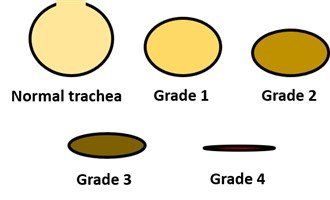Yorkshire Terrier Collapsed Trachea
What is Collapsed Trachea?
Collapsed trachea (tracheal collapse) in canines is a condition that affects a dog’s trachea (windpipe). The trachea connects the throat to the lungs. It is surrounded by tracheal rings which are made of cartilage and are held together by membrane tissue. Together, the rings and membrane serve as the supporting structure of a dog’s windpipe, keeping it open for proper air flow.
Collapsed trachea is characterized by the loss of rigidity and resulting sagging of membrane and/or weakening and resulting collapse of one or more tracheal rings. There are varying degrees and cases can be painful and progressive and ultimately can lead to moderately to severely affecting a Yorkshire Terrier’s ability to breathe.
Occurrence Rate with Yorkshire Terriers
Age of Onset
Causes
Symptoms
- A honking-type cough. This is sometimes referred to as a ‘goose honk’ and is the #1 sign. During a coughing episode, a dog may take a stance of extending their neck and spreading their elbows apart as if trying to expel something up. Generally, coughing progressively worsens over time.
- Noisy breathing (gasping, rattling, or wheezing noises)
- Gagging while eating
- Breathing difficulties (trouble catching their breath, exercise intolerance, etc.)
- Symptoms may be more apparent during or after exercise, when excited, or when breathing in cold air or hot, humid air
- Advanced cases may involve cyanosis (low oxygen levels in the blood may cause gums to turn blue) and/or fainting
How This is Diagnosed
There are 4 grades (levels) of severity:
Grade 1: The tracheal membrane is hangs slightly, cartilage is still its normal shape, the tracheal opening is reduced approximately 25%.
Grade 2: The tracheal membrane is hanging, cartilage is partially flattened, the tracheal opening is reduced approximately 50%.
Grade 3: The tracheal membrane is almost in contact with the opposite side of the windpipe (dorsal trachea), cartilage is nearly flat, the tracheal opening is reduced approximately 75%.
Grade 4: The tracheal membrane is completely touching the opposite side of the windpipe (dorsal trachea), cartilage is flattened and may invert, the tracheal opening is essentially non-functioning.
Treatment, Non-Surgical
Current studies have shown that approximately 70% of dogs respond well to non-surgical treatment. Since surgery (details coming up) is quite drastic, all of these options should be considered. Note that in most cases, it is a combination of several, and sometimes all, non-surgical treatments that will help alleviate symptoms. Rarely will just one result in improvement.
Non-surgery treatment for Yorkshire Terriers with collapsed trachea includes:
- Immediate discontinuation of a collar. A collar should never be worn again;
a harness will be used when on leash (this is also recommended to help prevent this issue).
- Limit exposure to cold air. Outdoor activity should be limited on cold days below 32 F (0 C).
- Limit over-excitement. Steps are taken to keep a dog calm. Introductions, activities, are more are done in a gradual, controlled manner.
- Avoidance of exercise during heat/humidity. Outdoor activity should be limited on hot, humid days, 80 F (27 C) or higher.
- Weight loss, if applicable. Though excess weight is typically not a problem with the Yorkshire Terrier, if the dog is carrying excess weight, they will be put on a diet. Even a couple of extra pounds can make a big difference.
Treatment, Medication
- Cough suppressants. Cough medications such as hydrocodone or dextromethorphan may be given.
- NSAIDs (nonsteroidal anti-inflammatory drugs) such Rimadylor Etogesic can help with pain and inflammation.
- Corticosteroids such as prednisone may be given to help reduce pain and inflammation. Due to the risk of both short and long-term side effects, dogs must be carefully monitored.
- Antibiotics. This is given as needed for possible secondary lower respiratory tract infections.
Treatment, Surgical
If non-surgical treatment does not produce any relief and if a dog is having severe breathing difficulties and/or is in a lot of discomfort, surgery may be recommended. This involves using a mesh-type sleeve to reinforce the trachea, along with prosthetic polypropylene rings to form a tube that will properly support the windpipe.
The success rate of this surgery is 75% or higher, though it is very extensive and there are risks including bleeding, paralysis of the larynx (voice box), and/or severe internal swelling that can lead to death. This surgery is most often successful with dogs under the age of 6.
Yorkshire Terrier Dos and Don'ts - This is a wonderful roundup of the most important 'dos' and the most vital 'don'ts' for this amazing toy breed dog. For both puppies and adults.

